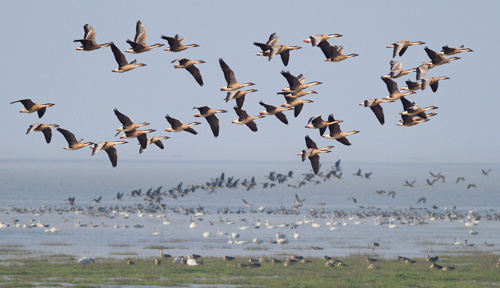| Location: Home>News>Events |
| Researchers reveals wild geese trapped in the Yangtze wetlands, their only winter home |
|
|
Results from hi-tech tracking of wild geese in China show that they are unwilling to leave their traditional wetland habitats to feed on farmland as they do in North America, Europe, neighboring Korea and Japan. New Chinese studies Are declining populations of wild geese in China ‘prisoners’ of their natural habitats? (http://www.cell.com/current-biology/fulltext/S0960-9822(17)30481-5) published in Current Biology (http://www.cell.com/current-biology/home) on World Biodiversity Day using the latest hi-tech tracking devices fitted to 67 wild geese of five different species show that they are faithful to their ancestral wintering habitats, remaining day and night within the safety of Yangtze River Floodplain wetlands. Novel light-weight loggers were attached to collars deployed on the geese when captured on the breeding areas (from Arctic Russia to the Mongolian Steppes) or on their Yangtze winter quarters. The GPS devices record where on the planet each goose is situated every hour, information relayed through the mobile phone network to Professor CAO Lei’s research team at the Research Center for Eco-Environmental Sciences (RCEES) in Beijing. Overlaying goose positions on 30 x 30 m China’s national ecosystem assessment land-cover maps showed whether geese were present on farmland or on natural wetlands. Goose species showing the greatest declines in numbers in China (Swan, Lesser White-fronted and Greater White-fronted Geese) all spent more than 98% of all their time on wetlands, while Greylag and Bean Geese (which are declining less rapidly) spent up to 18% of their time outside of wetlands (usually on farmland). This explains why the same species of geese feeding on farmland in Korea and Japan are increasing. Chinese geese therefore remain confined to their wetlands, choosing to avoid adjacent rice paddies and cereal fields, probably because farmers graze their own geese and duck flocks (removing the food) and illegal hunters persecute the wild geese if they leave Chinese wetlands. This also explains why previous studies showed that wintering goose numbers are declining in relation to degradation and loss of wetland habitats associated with economic development in the Yangtze catchment. Professor CAO Lei’s team continues to investigate how changes in water quantity and quality drive declines in waterbird abundance and diversity in the Yangtze River Floodplain wetlands.
Swan Goose in Poyang Lake, the Yangtze, China. Photo by Huigong YU State Key Laboratory of Urban and Regional Ecology May 23, 2017 |
